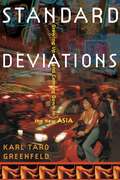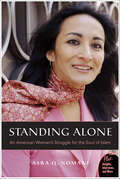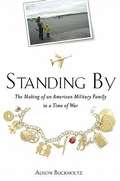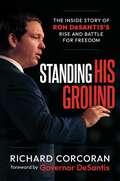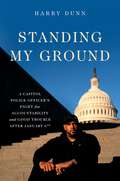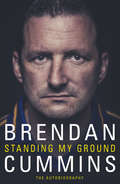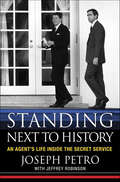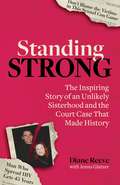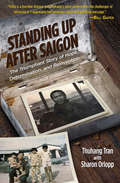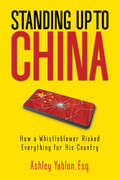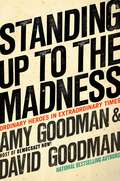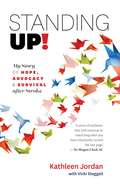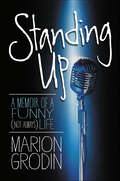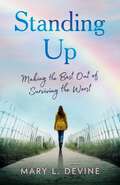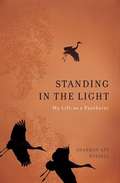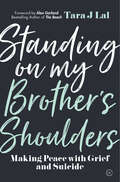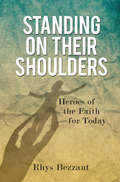- Table View
- List View
Standard Deviations: Growing Up and Coming Down in the New Asia
by Karl Taro Greenfeld"I was twenty-three and I had set off for Asia to become a writer, intrigued by lurid tales of booms, busts, drugs, sex, violence, magic. There was a wicked sorcery in Asia, in the economic profligacy of the early nineties, in the way financiers and businessmen took a rapidly wiring and developing continent and looted billions, like a titanic parlor trick converting all that wealth into abandoned office complexes and half-completed shopping malls. . . . I wanted it all--the money, the sex, the drugs. And to this day I believe that if I am honest with myself, despite all I have learned the hard way over the past decade, I would still want it all again, the fucking and the getting loaded and the scheming to get enough money to pay for that life."In the late 1980s, not long out of college, Karl Taro Greenfeld found himself stranded in New York, a failed writer before his career had even begun. His Jewish-American father angrily cut off support; his Japanese mother suggested he go to Japan to teach English. He did, accepting a job with no more promise than he'd had before. But he stayed in Asia for the next several years, working his way through a series of journalistic posts, watching a culture erupt before his eyes and facing his own demons. Through a series of vividly imagistic stories that range from the rigidly journalistic to the deeply intimate, Standard Deviations recounts Greenfeld's experiences--both professional and personal--during Asia's wild ride at the end of the twentieth century. Whether drinking Japanese cough syrup to get high with other Western expatriates, visiting a free-sex ashram in Bombay, or watching a former high school pal self-destruct as an equity analyst in Jakarta, Greenfeld evokes the spirit of a continent in flux at an explosive "bubble" economy's end--and a man confronting his own identity and aspirations.Raunchy, insightful, eloquent and moving, Standard Deviations is an uncompromising work of cultural observation and self-exploration.From the Hardcover edition.
Standing Alone: An American Woman's Struggle for the Soul of Islam
by Asra NomaniAs President Bush is preparing to invade Iraq, Wall Street Journal correspondent Asra Nomani embarks on a dangerous journey from Middle America to the Middle East to join more than two million fellow Muslims on the hajj, the pilgrimage to Mecca required of all Muslims once in their lifetime. Mecca is Islam's most sacred city and strictly off limits to non-Muslims. On a journey perilous enough for any American reporter, Nomani is determined to take along her infant son, Shibli -- living proof that she, an unmarried Muslim woman, is guilty of zina, or "illegal sex." If she is found out, the puritanical Islamic law of the Wahabbis in Saudi Arabia may mete out terrifying punishment. But Nomani discovers she is not alone. She is following in the four-thousand-year-old footsteps of another single mother, Hajar (known in the West as Hagar), the original pilgrim to Mecca and mother of the Islamic nation.Each day of her hajj evokes for Nomani the history of a different Muslim matriarch: Eve, from whom she learns about sin and redemption; Hajar, the single mother abandoned in the desert who teaches her about courage; Khadijah, the first benefactor of Islam and trailblazer for a Muslim woman's right to self-determination; and Aisha, the favorite wife of the Prophet Muhammad and Islam's first female theologian. Inspired by these heroic Muslim women, Nomani returns to America to confront the sexism and intolerance in her local mosque and to fight for the rights of modern Muslim women who are tired of standing alone against the repressive rules and regulations imposed by reactionary fundamentalists.Nomani shows how many of the freedoms enjoyed centuries ago have been erased by the conservative brand of Islam practiced today, giving the West a false image of Muslim women as veiled and isolated from the world. Standing Alone in Mecca is a personal narrative, relating the modern-day lives of the author and other Muslim women to the lives of those who came before, bringing the changing face of women in Islam into focus through the unique lens of the hajj. Interweaving reportage, political analysis, cultural history, and spiritual travelogue, this is a modern woman's jihad, offering for Westerners a never-before-seen look inside the heart of Islam and the emerging role of Muslim women.
Standing By
by Alison BuckholtzAlison Buckholtz never dreamed she would marry a military man, but when she met her husband, an active-duty Navy pilot, nothing could stop her from building a life with him- not even his repeated attempts to talk her out of marriage. He didn't want her to have to make the kinds of sacrifices long required of the spouses of military personnel. They wed shortly after September 11, 2001 and, since then, their life together has been marked by long separations and unforeseen challenges, but also unexpected rewards. Standing By is Buckholtz's candid and moving account of her family's experiences during her husband's seven-month deployment on an aircraft carrier in the Persian Gulf. With insight and humor she describes living near a military base in Washington State, far from home and in the midst of great upheaval, while trying to keep life as normal as possible for the couple's two young children. But she is not alone in her struggle. In Standing By, Buckholtz portrays her friendships with other military wives and the ways in which this supportive community of women helps one another to endure-to even thrive-during difficult times. Throughout Standing By, Buckholtz speaks honestly about the culture shock she experienced transitioning into the role of a military wife. Because she had been raised to conquer the world on her own terms rather than be a more traditional wife and mother supporting her husband's career, the world of the Armed Forces was at first as unfamiliar as a foreign land. But a remarkable and surprising series of events has challenged her long-held assumptions about the military, motherhood, and even the nature of American citizenship. A rare and intimate portrait of one of the tens of thousands of families who now wait patiently for their service member to return home safely, Standing By is a window into what matters most for families everywhere
Standing His Ground: The Inside Story of Ron Desantis's Rise and Battle for Freedom
by Richard CorcoranContrary to what the mainstream media has claimed, Florida under Ron DeSantis has become the home for freedom and individual liberty.At the onset of the pandemic, political leaders throughout the country were forced to quickly make significant decisions about how they would govern under extraordinary circumstances. A number of these decisions simply required instinct—they just had to come from the gut. There was little, if any, precedent to examine, and hardly any time for the usual gambits to test potential solutions. One person became a household name and a national hero for having made what proved to be the best decisions over and over: Ron DeSantis, the 46th governor of Florida. However, not surprisingly, his success also begot wrath. A patriot to millions of everyday Americans is often a &“tyrant&” to progressive elites. Other than perhaps former President Donald Trump, DeSantis was and remains the most vilified elected official in media, politics, entertainment, academia, and now the corporate world. Conservatives know full well this means he hit the bullseye. Now that more than two years have passed, the American people are able to clearly see whose decisions struck the proper balance between liberty and safety. There&’s no denying that DeSantis&’s influence soared as the world watched him successfully steer his state step by step through one of the greatest periods of turmoil and uncertainty in modern history. While many other states floundered, Florida didn&’t just survive—it flourished.
Standing My Ground: A Capitol Police Officer's Fight for Accountability and Good Trouble After January 6th
by Harry DunnNew York Times Bestseller The stirring memoir of Harry Dunn, a Capitol Police Officer on duty January 6th, who has become one of the most prominent and essential voices regarding the truth of that day, and &“a must-read for those care about our nation&’s future&” (Congressman Eric Swalwell). Walking the halls of democracy as a Capitol Police officer, Harry Dunn was a man slowly experiencing an awakening. It sparked after the election of our first Black president. It grew as his belief in the bravery and honor of law enforcement was shaken by Ferguson and countless other cases of police brutality towards the Black community. It continued to burn brighter as he watched members of Congress, many of whom he had befriended, lose their way to partisanship, as political extremism intensified. And it exploded into a blaze when he fought side by side with his fellow officers on January 6th, when democracy and their lives were threatened.Standing My Ground is &“a powerful, patriotic tale – told with striking moral clarity&” (Congresswoman Nancy Pelosi) that provides a crucial, definitive firsthand account of what happened on that day our country was shocked to its core. But it will also share the story of a man who refused to stay quiet when he learned that some of the men and women he had risked his life protecting, who knew him by name, would deny the horrors they faced. That&’s when he chose to speak up and to seek out what his hero John Lewis once termed &“good trouble.&” Dunn&’s ongoing story as a witness willing to meaningfully engage with the media, lawmakers, and the public provides a backdrop for examining the political and racial divide in this country—one that we must overcome in order to demand accountability and preserve our precious democracy.
Standing My Ground: The Autobiography
by Brendan CumminsBrendan Cummins has made more senior hurling championship appearances than any other player in the history of the game. In an era that produced such brilliant goalkeeping talents as Davy Fitzgerald, Donal Óg Cusack and Damien Fitzhenry, many would argue that Cummins has earned the right to be considered the greatest of them all. Following his League debut for Tipperary in November 1993, Cummins went on to play at the top of the intercounty game for 19 consecutive seasons. He won two senior All Ireland medals, five Munster championships, four League titles and five All Star awards.From fearless shot-stopping to pinpoint accuracy on his puck-outs, Cummins was unrivalled in the consistency of his performances, a consistency underpinned by a sometimes punishing physical commitment, mental discipline and great attention to detail. He was the rock upon which Tipperary built their team under many managers and changes of personnel. Brendan Cummins' story is the story of Tipperary hurling over the last two decades. The ups and downs. The dramas. The characters. From his senior championship debut in 1995 under Fr. Tom Fogarty to his final games under Eamon O’Shea, Cummins has seen it all. Standing My Ground is a remarkable account of an extraordinary career.
Standing Next to History: An Agent's Life Inside the Secret Service
by Jeffrey Robinson Joseph PetroA former Secret Service agent revisits his twenty-three-year career, including his time as Ronald Reagan’s bodyguard, in this “engaging” memoir (Publishers Weekly).Joseph Petro served for twenty-three years as a special agent in the United States Secret Service, eleven of them at the White House and four of those as the man on the shoulder of Ronald Reagan.From his days as an investigator in the field, to his time as the man on whom the life of the president depended, Petro’s journey through history is a singular look inside the most discreet law enforcement agency in the world; an unparalleled insight into Ronald and Nancy Reagan; plus an up-close-and-personal view of the late Pope John Paul II, whom Petro protected during his historic and extraordinary ten-day tour of the United States in 1987.The cast of characters in these never-before-told stories ranges from the Reagans and the Pope, to Frank Sinatra, Bob Hope, Mikhail Gorbachev, Fidel Castro, Margaret Thatcher, François Mitterrand, the Shah of Iran, George H. W. Bush, Dan and Marilyn Quayle, Henry Kissinger, Nelson Rockefeller, Gerald Ford, and would-be assassins.“A close-in view of how ‘the Great Communicator’ charmed critics and won loyal followers.” —The Christian Science Monitor“A fascinating portrait of Secret Service life.” —Library Journal
Standing Our Ground: The Triumph of Faith Over Gun Violence: A Mother's Story
by Rosemarie Robotham Lucia Kay McBathFrom the national spokesperson for Everytown for Gun Safety and leading gun violence prevention advocate comes the riveting memoir of a mother’s loss and call to action, as well as a faith-based exploration of how the nation’s gun laws put a deadly target on American lives.Lucia Kay McBath knew deep down that a bullet could one day take her son. After all, she had watched the news of countless unarmed black men unjustly gunned down. Standing Our Ground: Putting Faith in God Over Faith in Guns is McBath’s memoir of raising, loving, and losing her son to gun violence, and the story of how she transformed her pain into activism. After seventeen-year-old Jordan Davis was shot by a man who thought the music playing on his car stereo was too loud, the nation grieved yet again for the unnecessary loss of life. Here, McBath goes beyond the timeline and the assailant’s defense—Stand Your Ground—to present an emotional account of her fervent fight for justice, and her awakening to a cause that will drive the rest of her days. But more than McBath’s story or that of her son, Standing Our Ground keenly observes the social and political evolution of America’s gun culture. A must-read for anyone concerned with gun safety in America, it harkens back to such bestsellers as The Short and Tragic Life of Robert Peace and Nobody.
Standing Strong
by Teresa GiudiceThe Real Housewives of New Jersey star and New York Times bestselling author Teresa Giudice opens up about her tumultuous past year in her emotional new memoir Standing Strong.In her second memoir, Teresa chronicles her life since her release from prison and what it’s been like to weather difficult times as a single mother. Though she recounts the happy memories she has experienced over the past year, she also touches upon some of the darkest times of her life, including her parents' hospitalizations for severe medical issues in late 2016, which led to the tragic passing of her mother in March of 2017. With unparalleled honesty and courage, Teresa opens up in Standing Strong in ways she never has before, showing her fans what it truly means to be a survivor.
Standing Strong: An Unlikely Sisterhood and the Court Case that Made History
by Diane ReeveDiane Reeve thought she had found everything in handsome Frenchman Philippe Padieu. Believing him to be her last great love, she spent every Monday, Wednesday, and Saturday with him for four years, and they were about to buy a house together. When Diane learned he had Tuesday, Thursday, Friday, and Sunday women, too, she was devastated. But the pain was just beginning. A week after their breakup, during a routine exam, she tested positive for an STD. After calling every woman she found in Philippe's phone records, she was told to get tested for something much worse: HIV. The sick reality was that Philippe was deliberately infecting multiple women—women in their 20s through 60s, with little in common except their vulnerability. It was a sisterhood none of them wanted to belong to, but it became their lifeline as they struggled with anger, the specter and stigma of an HIV diagnosis, and failing health. Despite plummeting t-cell numbers and declining health, Diane vowed to stop Philippe from victimizing anyone else. In a race against time, she tracked down as many of his conquests as possible. Against all odds, this unlikely group made legal history, successfully prosecuting Padieu and sending him to prison for assault with a deadly weapon. This fascinating case—won only through the help of new DNA science—is Diane's story of victory and her mission to bring awareness and empowerment to others. As she explains, "Courage is doing what's right, even when you're afraid."
Standing Tall
by Craig Kielburger Marc Kielburger Susan Mcclelland Spencer WestSpencer West is many things. Accomplished speaker. University graduate. Natural prankster. Former cheerleader. And a young man without legs--something that has never held him back. Spencer was born without the use of his legs. When he was five, doctors decided to amputate below his pelvis to better help him get around. It didn't bother him; he was Superman and nothing would ever get in his way. Or so he thought. Navigating through life on his hands, Spencer has always lived with purpose. But he wanted more out of life than just a paycheque and material possessions. He wanted to make an impact but wasn't always sure how. That was until he had the epiphany: He was different for a reason. Infused with humour and humility, Spencer has never lost the hope or courage he needed to tackle personal obstacles--bullying, isolation, failure, or pride. His secret? Always standing tall.
Standing Tall: A Memoir of Tragedy and Triumph
by Laura Tucker C. Vivian Stringer"Lots of people have dreams, but C. Vivian Stringer . . . lives that dream, teaching others to rise up to meet challenges, turning underdogs into champions again and again--on and off the court. This is the quintessential American story, of a woman and of a family pulling together against the odds"--John Chaney, Hall of Fame college basketball coach.
Standing Up After Saigon: The Triumphant Story of Hope, Determination, and Reinvention
by Thuhang Tran Sharon OrloppThis inspiring true story of familial love and triumph through adversity follows a father and daughter separated by war in Vietnam. In 1970, near the end of the Vietnam War, Thuhang Tran was born in Saigon. She contracted polio as a baby, and though her family sacrificed much to seek treatment, their efforts were halted by Saigon&’s fall. Her father, Chinh Tran, an air traffic controller in the South Vietnam Air Force, was lost during the evacuations and presumed dead. This powerful memoir follows both father and daughter through their respective struggles, from Thuhang's battle with polio and the impact of her father's absence, to Chinh's immigration to the United States and his desperate 15-year mission to be reunited with his family. Through all the seemingly impossible hurdles she&’s faced, Thuhang has remained hopeful and resilient. Now she tells her incredible story, inspiring those around her to find strength through perseverance.
Standing Up to China: How a Whistleblower Risked Everything for His Country
by Ashley YablonWhat would you do if your ambitious career suddenly transformed into a deadly game of international espionage? A true-life thriller equal to that of a heart-stopping John Grisham novel, Ashley Yablon's story takes readers into the dark crevices of deceit and corporate greed of one of the world's most powerful Chinese telecom giants. As the freshly minted General Counsel for telecom company ZTE, Yablon uncovers an illegal scheme selling billions of dollars' worth of surveillance equipment to embargoed countries. If left unchecked, these transactions could threaten the security of the United States at the highest levels. Instead of turning a blind eye, Yablon risks everything, including his life and career, to uphold justice - leading him down a course of personal and professional destruction. In this modern-day story of David and Goliath, Yablon goes head-to-head with some of the most dangerous and powerful Chinese crime bosses in the world.
Standing Up to the Madness: Ordinary Heroes in Extraordinary Times
by Amy GoodmanStanding Up to the Madness not only is a timely, inspiring, and even revolutionary look at who wields the greatest power in America--everyday people who take a chance and stand up for what they believe in--but also offers advice on what you can do to help. Where are the millions marching in the streets to defend human rights, civil liberties, and racial justice? Where is the mass revulsion against the killing and torture being carried out in our name? Where are the environmentalists? Where is the peace movement? The answer: They are everywhere. The award-winning sister-brother team of Amy Goodman, host of Democracy Now!, and investigative journalist David Goodman traveled the country to detail the ways in which grassroots activists have taken politics out of the hands of politicians. Standing Up to the Madness tells the stories of everyday citizens who have challenged the government and prevailed. As the Bush administration has waged war abroad and at home, it has catalyzed a vast groundswell of political action. From African-American residents of deluged New Orleans who are fighting racism and City Hall to regain their homes; to four Connecticut librarians who refused to spy on their patrons, challenged the USA PATRIOT Act, and won; to a group of high school students who were barred from performing a play they wrote on the Iraq War based on letters from soldiers; to the first U.S. Army officer to publicly refuse orders to deploy to Iraq, charging that his duty as an officer is to refuse to fight in an illegal and immoral war, Standing Up to the Madness profiles citizens rising to extraordinary challenges. And, in the process, they are changing the way that politics is done, both now and in the future. In communities around the United States, courageous individuals have taken leaps of faith to stop the madness. They could only hope that if they led, others would follow. That is how movements are born. What begins as one, eventually becomes many. In that tradition, the authors have included the ways in which any individual can take action and effect change.
Standing Up!: My Story Of Hope, Advocacy And Survival After Stroke
by Kathleen Jordan Vicki StegallKathleen Jordan was a vibrant businesswoman, mother and grandmother until one morning in August 2011, she suffered a massive stroke and her world was turned upside. Her memoir Standing Up! gives a detailed and compelling insight into the effects of major stroke and the vital support and advocacy needed when she could not stand up for herself. Kathleen Jordan, with Vicki Steggall, recounts her journey through stroke, from the acute trauma, through to the stroke ward, short and long term rehabilitation units and, finally, her amazing recovery to return to semi-normalcy and everyday life. Jordan and Steggall reinforce the powerful role advocacy, family support and determination play in recovery and give specific strategies and advice to families who are feeling under-supported by medical limitations.
Standing Up: A Memoir of a Funny (Not Always) Life
by Marion GrodinMarion Grodin, daughter of funnyman Charles Grodin, knows firsthand that laughter is truly the best medicine, having not only survived breast cancer and divorce, but also, various addictions-including an inappropriate relationship with Haagen Dazs.Her hilarious riffs include; the story of growing large breasts that appeared seemingly overnight (Unfortunately this happened during the summer that she spent on the set of King Kong with her father and Jeff Bridges on whom she developed a huge crush); Her post divorce life, its slight weight gain and how she relied on her wise support group, her cats "BabyFighter" Edmond and "fashionably sporty, forensic expert" Snuggles. In this cleverly written memoir Marion integrates her diverse and challenging life experiences and unstoppable ability to make everything funny in a way that is both entertaining and helpful. She hopes that her book will send a message to those who feel they are misfits and to those locked in addiction: there is a way out - and life can be very good when you kick the habit.
Standing Up: Making the Best Out of Surviving the Worst
by Mary L. DevineFor true-crime fans, a gripping memoir of a domestic violence survivor who becomes a police detective in the domestic violence unit and is forced to face her demons when her first major case mirrors her own violent assault.Standing Up invites you on an exhilarating journey with a woman who refuses to be defined by her scars. A pulse-pounding chronicle of survival against all odds, this memoir takes readers along on a plunge into the chilling depths of abusive relationships. At the tender age of twenty-three, Mary Sweeney-Devine unwittingly stumbled into the clutches of her abuser, igniting anguish and despair. With each heart-wrenching trial, including a hospital visit, she unearthed a reservoir of resilience she didn&’t know she possessed. But just when she thought she had weathered the storm, a second marriage to a recovering alcoholic unleashed a tempest of secrets and unforeseen challenges. Yet Devine emerged from the darkness, fueled by an unyielding determination and a fierce spirit. With the help of unexpected allies, determination, and a sprinkling of humor, she navigated the treacherous terrain of her past—and reclaimed her life with courage. Offering hope to those ensnared in the vicious cycle of abuse, Standing Up is a riveting testament to Devine&’s indomitable spirit and a gripping saga that will leave you breathlessly rooting for the victory of the human heart over adversity.
Standing in the Light: My Life as a Pantheist
by Sharman Apt RussellEverything is connected, and the web is holy. So wrote Marcus Aurelius, the starting point of Sharman Russell's wise and haunting new memoir about her life as a pantheist. Perhaps no other religious philosophy is as simple and inclusive as pantheism.
Standing in the Wings: The Beatles, Brian Epstein and Me
by Philip Norman Joe Flannery Mike BrockenJoe Flannery has been described as the ‘Secret Beatle’, and as the business associate and partner of Brian Epstein, he became an integral part of The Beatles’ management team during their rise to fame in the early 1960s.Standing in the Wings is Flannery’s account of this fascinating era, which included the controversial dismissal of Pete Best from the group (nothing to do with London, but matters back in Liverpool), Brian Epstein’s fragility, and the importance of the Star Club in Hamburg. This book is not simply a biography, as it also considers issues to do with sexuality in 1950s Liverpool, the vagaries of the music business at that time and the hazards of personal management in the ‘swinging sixties’. At its heart, Standing in the Wings provides an in-depth look at Flannery’s personal and professional relationship with Epstein and his close links with the Fab Four. Shortly before John Lennon’s murder in 1980, it was Flannery who was one of the last people in the UK to talk to the great man. Indeed, Flannery remains one of the few ‘Beatle people’ in Liverpool to have the respect of the surviving Beatles, and this is reflected in this timely and revealing book.
Standing on Her Shoulders
by Monica Clark-RobinsonA stunning love letter to the important women who shape us -- from our own mothers and grandmothers to the legends who paved the way for girls and women everywhere.Standing on Her Shoulders a celebration of the strong women who influence us -- from our mothers, sisters, aunts, and grandmothers to the women who fought for equality and acceptance in the United States.Monica Clark-Robinson's lyrical text encourages young girls to learn about the powerful and trailblazing women who laid the path for their own lives and empowers them to become role models themselves. Acclaimed illustrator Laura Freeman's remarkable art showcases a loving intergenerational family and encourages girls to find female heroes in their own lives.Standing on Her Shoulders will inspire girls of all ages to follow in the footsteps of these amazing women.
Standing on My Brother's Shoulders: Making Peace with Grief and Suicide - A True Story
by Tara LalEverything finds its place, just as the colour and the beauty do, so does the pain. Tara Lal's childhood was battered by her father's mental illness and by her mother's death when she was thirteen. Caught up in grief and despair, she developed a deep, caring bond with her charismatic and kind older brother Adam, though he struggled silently with growing anxiety and depression. Four years after their mother's death, Adam committed suicide. Grief and insecurity threatened to engulf Tara, but eventually she found, through a dialogue with the words her brother left behind in his diaries, her reason to live. The book includes an Afterword on the possibilities for recovery and growth following a tragedy, written by Miriam Akhtar, author of Positive Psychology for Overcoming Depression.From the Trade Paperback edition.
Standing on One Foot
by Kenneth JerniganThis is book six of the Kernel Series. The ways of overcoming challenges that face individuals who want a normal life in spite of blindness is revealed in these short true-to-life stories.
Standing on Their Shoulders: Heroes of the Faith for Today
by Rhys BezzantBeing a Christian means being part of a bigger story, for God has worked in the course of history to make a people for himself. There is great joy in being part of this story, because we are spared the anxiety of creating ourselves out of nothing. Rather than going it alone, we stand on the shoulders of those before us in the faith, and consequently see further.The studies in Heroes of the Faith tell the stories of twelve great heroes of the faith from the last two thousand years of history. Sometimes their strengths drove their story, sometimes their weaknesses, but their lives left others profoundly changed. From each of these flawed but faithful mentors, we can draw courage and receive spiritual nurture as we contend for the faith today.
Standing on the Shoulders: Incredible Heroes and How They Inspire Us
by Dan Walker'SUCH AN INCREDIBLE READ' ZOE BALL'ONE OF THE YEAR'S MOST INSPIRING BOOKS' HOLLY WILLOUGHBYWith a foreword by 2021 Strictly Come Dancing winner Rose Ayling-Ellis.Dan Walker is back, determined to keep shining a light on the kindness, compassion and selflessness which continue to characterise so many people and their actions right across the country.As one of the UK's leading journalists, Dan has made it his life work to focus on people who often act as the catalysts for change: the unheralded champions who frequently go without getting the recognition they deserve.The new book from the author of the bestselling Remarkable People contains a totally fresh batch of humble heroes whose actions, bravery and determination have helped shape their communities. Standing on the Shoulders asks who are these little-known marvels and what makes them tick? What do they have in common? What can we all learn from them? Is there something special in the chain of events? What does it take to make a lasting impact on others?History can be cruel and forgetful to those who don't shout about their own success or good deeds, but Standing on the Shoulders is a beautifully-written and illuminating celebration of ordinary people and the extraordinary things they do. It is also a timely reminder of the goodness and positivity that drives us forward during challenging times.
